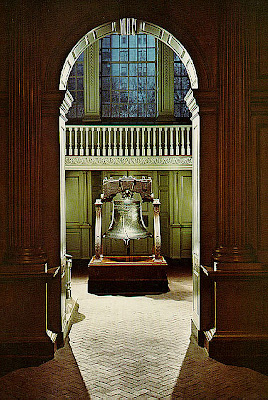On July 8, 1776 the Liberty Bell rang to mark the reading of the Declaration of Independence.
The Liberty Bell inscription: Proclaim LIBERTY throughout all the Land unto all the Inhabitants thereof Lev. XXV X By Order of the ASSEMBLY of the Province of PENSYLVANIA [sic] for the State House in Philada.
Pass and Stow Philada MDCCLIII (1753)
A bell for the Pennsylvania State House was cast in London, England, however, it cracked soon after it arrived in Philadelphia. Local craftsmen John Pass and John Stow cast a new bell in 1753, using metal from the English bell. Their names appear on the front of the bell, along with the city and the date. By 1846 a thin crack began to affect the sound of the bell. The bell was repaired in 1846 and rang for a George Washington birthday celebration, but the bell cracked again and has not been rung since. No one knows why the bell cracked either time.
The bell weighs about 2000 pounds. It is made of 70% copper, 25% tin, and small amounts of lead, zinc, arsenic, gold, and silver. It hangs from what is believed to be its original yoke, made from American elm, also known as slippery elm.
The old State House bell was first called the "Liberty Bell" by a group trying to outlaw slavery. These abolitionists remembered the words on the bell and, in the 1830s, adopted it as a symbol of their cause.
This image or file is a work of an employee of the United States Federal Government, taken or made during the course of the person's official duties. As a work of the U.S. federal government, the image or file is in the public domain.
Generally speaking, works created by U.S. Government employees are not eligible for copyright protection in the United States. See Circular 1 "COPYRIGHT BASICS" PDF from the U.S. Copyright Office.
TEXT CREDIT: Independence National Historical Park (U.S. National Park Service)















No comments:
Post a Comment